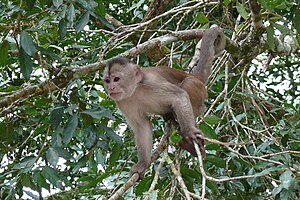Marañon Capuchin Monkey
| Marañon Capuchin Monkey | ||||||||||||
|---|---|---|---|---|---|---|---|---|---|---|---|---|

Marañon Capuchin Monkey photographed on the banks of the Napo River in Ecuador |
||||||||||||
| Systematics | ||||||||||||
|
||||||||||||
| Scientific name | ||||||||||||
| Cebus yuracus | ||||||||||||
| Hershkovitz , 1949 |
The Marañon Capuchin Monkey ( Cebus yuracus , Syn . : C. albifrons yuracus ) is a species of primate from the Capuchin family that occurs in the western Amazon basin . Its distribution area lies between the Río Putumayo in the north, the Río Ucayali and the upper reaches of the Amazon in the south and the eastern slope of the Andes in the west and thus includes the extreme southeast of Colombia, the east of Ecuador, the north of Peru and a triangular, to Eastern pointed region in the west of Brazil.
features
The marañon capuchin monkey reaches a weight of 2 to 4.7 kg, has a head-trunk length of 37 cm (females) to 43 cm (males) and a 45 to 47 cm long tail. It is olive brown in color with lighter sides and a light belly. The face, chest and outer sides of the arms are gray, the cap on the top of the head is very dark brown. The front of the tail has the same brownish color as the back, but becomes lighter towards the end.
Way of life
Marañon capuchin monkeys live in groups of 5 to 35 animals in rainforests (terra firme forest) in the western Amazon basin that are not periodically flooded but are very rainy. They feed on fruits, insects and other arthropods, flowers, seeds, bird eggs and small vertebrates. They spend about 10% of their day ingesting plant foods and 50% or more looking for animal foods.
Danger
The IUCN does not yet list the marañon capuchin monkeys in its red list. In the Handbook of the Mammals of the World , the population in Ecuador is listed as Near Threatened and in Peru as Vulnerable. The species occurs in numerous nature reserves, for example in Pacaya-Samiria in Peru and in the Cuyabeno nature reserve and the Sangay and Yasuní national parks in Ecuador.
literature
- Anthony B. Rylands, Russell A. Mittermeier, Bruna M. Bezerra, Fernanda P. Paim & Helder L. Queiroz: Family Cebidae (Squirrel Monkeys and Capuchins). Page 407 in Russell A. Mittermeier , Anthony B. Rylands & Don E. Wilson : Handbook of the Mammals of the World - Volume 3: Primates. Lynx Edicions, 2013 ISBN 978-8496553897